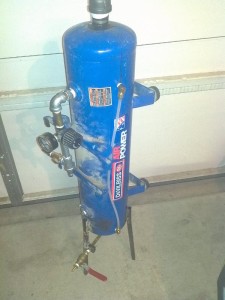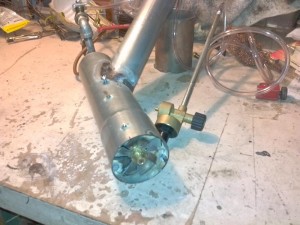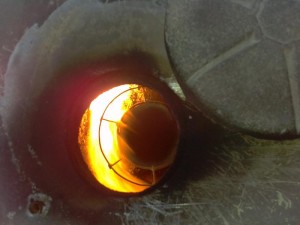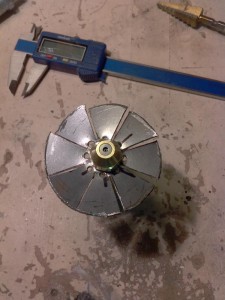The knock against oil is it’s hard to burn, it’s messy, and it burns to smokey. At first, I agreed. I got the burner finished and tried it out. It would barely start, would only burn on propane, the oil just wouldn’t burn. No matter how long I burned the propane, the damn thing wouldn’t stay lit! Frustrated, I went back and re-read everything I could find. First thing I learned was that the burner was too far in the tuyere (burner pipe) – the propane was trying to heat up the entire foundry and not just the tuyere. I pulled the burner back and sure enough the burner sustained itself on oil. It burned great! It was April and the oil was flowing. I let it sit until this past December, 2013. The burner didn’t work so well. In fact, it didn’t work at all – back to the drawing board. Or in this case, back to the forums at Alloy Avenue. It would seem that oil gets more viscous (duh) when it’s colder and needs help to move. Research showed some guys preferred a low pressure pump to pull oil while the overwhelming favorite was a pressurized tank with low pressure. Easiest is best – I went with the pressurized tank.
My father-in-law had given me one of those mini compressors because he thought I might be able to get it to work. Something turned out to be wrong with the compressor so I ended up using the tank off of it. I took off all the plumbing and attachments, welded on three legs and set it up on the legs. I added plumbing for a pressure regulator and an outlet for the oil on the bottom of the tank. It was surprisingly easy to do. It even has a fuel gauge level indicator. The last piece of the puzzle was the blower. At first I was running the burner normally aspirated, i.e., no blower. I added an old hair dryer, because it worked on a propane burner I saw at a demonstration for the Valley Metal group. It just didn’t seem to do enough for the burner, in fact, it seemed to almost choke it off. I finally paid heed to the guys on Alloy Avenue – I put the shop vac on it. Wow, what a difference!
to get it to work. Something turned out to be wrong with the compressor so I ended up using the tank off of it. I took off all the plumbing and attachments, welded on three legs and set it up on the legs. I added plumbing for a pressure regulator and an outlet for the oil on the bottom of the tank. It was surprisingly easy to do. It even has a fuel gauge level indicator. The last piece of the puzzle was the blower. At first I was running the burner normally aspirated, i.e., no blower. I added an old hair dryer, because it worked on a propane burner I saw at a demonstration for the Valley Metal group. It just didn’t seem to do enough for the burner, in fact, it seemed to almost choke it off. I finally paid heed to the guys on Alloy Avenue – I put the shop vac on it. Wow, what a difference!
Ok, now  for details on the burner. Basically it’s a Delavan siphon-fed burner in a burner tube made out of exhaust tubing. The tube itself has a ‘Y’ where a tube is welded on for the incoming air. The actual mechanics aren’t that difficult, some 3/8″ pipe for the compressed air and propane and some copper line for the oil that feeds the bu
for details on the burner. Basically it’s a Delavan siphon-fed burner in a burner tube made out of exhaust tubing. The tube itself has a ‘Y’ where a tube is welded on for the incoming air. The actual mechanics aren’t that difficult, some 3/8″ pipe for the compressed air and propane and some copper line for the oil that feeds the bu rner. At the opposite end from the burner is a plug where the lines come out. The only
rner. At the opposite end from the burner is a plug where the lines come out. The only  ‘special’ part of the burner is the turbulator – an air vane that cause the air to ‘spin’ that helps in combustion and helps create a vortex in the foundry that spins around the crucible. It’s actually very fascinating to watch the vortex except that it’s so damn hot.
‘special’ part of the burner is the turbulator – an air vane that cause the air to ‘spin’ that helps in combustion and helps create a vortex in the foundry that spins around the crucible. It’s actually very fascinating to watch the vortex except that it’s so damn hot.
